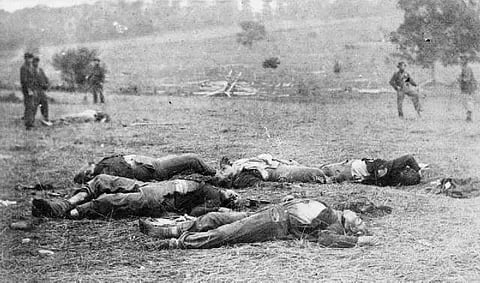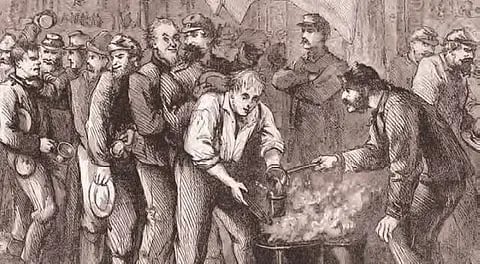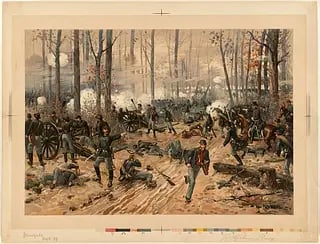American Civil War: Causes, Battles, and Lasting Legacy
Explore the American Civil War (1861–1865), from its causes like slavery to key battles like Gettysburg. Learn how it ended slavery and shaped modern America.


American Civil War: The Conflict That Redefined a Nation
Introduction
The American Civil War (1861–1865) remains one of the most transformative events in United States history, a brutal struggle that tested the nation’s unity and moral foundation. Fought between the Northern states (the Union) and the Southern states (the Confederacy), the war claimed an estimated 620,000–750,000 lives, making it the deadliest conflict in American history (Britannica: American Civil War). At its heart, the war was a battle over slavery’s expansion, states’ rights, and the future of the United States as a single nation.
This comprehensive blog post dives deep into the American Civil War, exploring its causes, key events, major figures, societal impacts, and enduring legacy. With a word count of approximately 2,500–3,000 words, this article is designed to be both informative and engaging, offering readers a thorough understanding of this pivotal period. Optimized for search engines, it incorporates keywords like “American Civil War,” “causes of the Civil War,” “major Civil War battles,” “Abraham Lincoln,” and “Emancipation Proclamation” to ensure high visibility and appeal to history enthusiasts, students, and curious readers alike.
From the secession of Southern states to the transformative Reconstruction era, this blog uncovers the complexities of a conflict that continues to shape American identity, politics, and debates on equality. Whether you’re researching the war’s impact or seeking to understand its modern relevance, this guide provides a detailed and accessible journey through America’s defining conflict.
Historical Context
In the early 19th century, the United States was a nation divided by economic, social, and political differences. The Northern states, increasingly industrialized, relied on factories, railroads, and wage labor, with a growing abolitionist movement opposing slavery. The Southern states, dependent on agriculture, particularly cotton, relied on enslaved labor, with approximately 4 million enslaved African Americans by 1860, making up about 33% of the South’s population (Wikipedia: American Civil War).
Key tensions included:
Slavery’s Expansion: The Missouri Compromise (1820) and Compromise of 1850 attempted to balance slave and free states, but the Kansas-Nebraska Act (1854) reignited conflicts over new territories, leading to violent clashes known as “Bleeding Kansas” (History.com: Civil War).
Political Polarization: The Republican Party, formed in 1854, opposed slavery’s expansion, while Democrats were split between pro-slavery Southerners and moderates. The Dred Scott decision (1857) further inflamed tensions by ruling that African Americans were not citizens and that Congress could not ban slavery in territories.
Cultural Divide: Abolitionist literature, like Harriet Beecher Stowe’s Uncle Tom’s Cabin (1852), fueled Northern opposition to slavery, while Southerners defended their “way of life” as essential to their economy and social order.
The election of Abraham Lincoln in November 1860, a Republican who opposed slavery’s expansion, became the catalyst for Southern secession, setting the stage for war.
Causes of the American Civil War
The American Civil War was the result of decades of simmering tensions, with slavery as the central issue, compounded by debates over states’ rights, economic disparities, and political power.
Slavery: The Core Conflict
Slavery was the primary cause of the Civil War. The Southern economy depended on cotton, which accounted for 60% of U.S. exports by 1860, driven by enslaved labor (World History Encyclopedia: American Civil War). Southern states sought to expand slavery into western territories to maintain political power in Congress, where the balance between slave and free states was critical. The North, with a growing abolitionist movement, opposed this expansion, viewing slavery as morally wrong and a threat to free labor.
Legislative efforts to resolve the issue, such as the Missouri Compromise (1820), which admitted Missouri as a slave state and Maine as a free state, and the Compromise of 1850, which allowed California to enter as a free state, only delayed conflict. The Kansas-Nebraska Act (1854), which allowed territories to decide on slavery through “popular sovereignty,” led to violent clashes, further polarizing the nation (PBS: Causes of the Civil War).
States’ Rights
Southern leaders framed secession as a defense of states’ rights, arguing that states could nullify federal laws they deemed unconstitutional, particularly those restricting slavery. However, this argument was largely a justification for preserving slavery, as Southern states supported federal power when it protected their interests, such as the Fugitive Slave Act of 1850, which required the return of escaped slaves (Britannica: Causes of the Civil War).
Economic and Social Differences
The North’s industrial economy, with factories, railroads, and small farms, contrasted sharply with the South’s agrarian, plantation-based system. These economic differences fueled competing visions for America’s future. The North favored tariffs to protect its industries and federal investment in infrastructure, while the South opposed such policies, fearing they would harm its export-driven economy. Socially, the North’s growing urban population and abolitionist sentiment clashed with the South’s hierarchical, slave-based society.
Political Tensions and Secession
The rise of the Republican Party and Lincoln’s election in 1860, without a single electoral vote from the South, convinced Southerners that their interests were no longer represented in the federal government. Between December 1860 and June 1861, 11 states—South Carolina, Mississippi, Florida, Alabama, Georgia, Louisiana, Texas, Virginia, Arkansas, Tennessee, and North Carolina—seceded, forming the Confederate States of America with Jefferson Davis as president (History.com: Secession).
Debated Causes
While slavery is widely accepted as the primary cause, some historians emphasize economic competition, cultural differences, or the South’s reliance on global cotton demand as contributing factors. Recent scholarship highlights how the economics of slavery, tied to international markets, intensified regional tensions, complicating narratives that focus solely on moral or political issues (PBS: Causes of the Civil War).
Key Events and Battles
The Civil War was marked by numerous battles and events that shaped its trajectory and outcome. Below is a detailed overview of the most significant:
Outbreak of War: Fort Sumter (April 12–14, 1861)
The war began when Confederate forces fired on Fort Sumter in Charleston, South Carolina, a federal stronghold. After a 34-hour bombardment, the Union garrison surrendered, prompting Lincoln to call for 75,000 volunteers to suppress the rebellion. This action led four more states to join the Confederacy (National Park Service: Fort Sumter).
Major Battles
First Battle of Bull Run (1861): Fought near Manassas, Virginia, this Confederate victory, with 4,700 casualties, dispelled hopes of a quick war and highlighted the need for better military preparation (History.com: Bull Run).
Battle of Shiloh (1862): In Tennessee, this battle resulted in over 23,000 casualties. Union General Ulysses S. Grant’s victory secured a strategic foothold but shocked both sides with its brutality.
Battle of Antietam (1862): The bloodiest single day in U.S. history, with 22,000 casualties. Although tactically inconclusive, it was a strategic Union victory, halting General Robert E. Lee’s invasion of the North and giving Lincoln the opportunity to issue the Emancipation Proclamation (National Park Service: Antietam).
Battle of Gettysburg (1863): Often considered the war’s turning point, this Union victory, with 51,000 casualties, repelled Lee’s second invasion of the North. Lincoln’s Gettysburg Address, delivered in November 1863, redefined the war as a fight for equality and democracy (Britannica: Gettysburg).
Siege of Vicksburg (1863): Grant’s 47-day siege captured Vicksburg, Mississippi, giving the Union control of the Mississippi River and splitting the Confederacy.
Atlanta Campaign (1864): General William T. Sherman’s capture of Atlanta, a key Confederate supply hub, boosted Northern morale and aided Lincoln’s re-election.
Sherman’s March to the Sea (1864): Sherman’s campaign from Atlanta to Savannah destroyed Southern infrastructure, weakening the Confederacy’s ability to fight (History.com: Sherman’s March).
Appomattox Court House (1865): Lee’s surrender to Grant on April 9, 1865, marked the war’s effective end, though smaller Confederate forces surrendered later (Britannica: Appomattox).
Emancipation Proclamation (January 1, 1863)
Lincoln’s proclamation declared enslaved people in Confederate territories free, encouraging 180,000 African Americans to join the Union Army. It reframed the war as a fight against slavery, gaining international support and discouraging foreign intervention (National Archives: Emancipation Proclamation).
End of the War
The war ended with Lee’s surrender at Appomattox, followed by other Confederate surrenders. Lincoln’s assassination by John Wilkes Booth on April 14, 1865, just days after Appomattox, shocked the nation and complicated Reconstruction efforts.
Military Strategies and Innovations
Union Strategy
The Union’s “Anaconda Plan,” proposed by General Winfield Scott, aimed to blockade Southern ports, seize the Mississippi River, and capture Richmond, the Confederate capital. With 2.1 million soldiers and superior resources, the Union leveraged its industrial strength to outlast the Confederacy (World History Encyclopedia: American Civil War).
Confederate Strategy
The Confederacy adopted a defensive strategy, aiming to protect its territory and outlast the Union, hoping for foreign support from Britain or France. Offensive campaigns, like Lee’s invasions of the North, sought to demoralize Union forces but often resulted in heavy losses.
Innovations
Rifled Muskets: Increased accuracy and range, raising casualty rates.
Ironclad Ships: The USS Monitor vs. CSS Virginia (1862) introduced armored naval warfare.
Railroads and Telegraph: Enabled rapid troop movement and communication.
Trench Warfare: Used in battles like Petersburg, foreshadowing World War I tactics (History.com: Civil War Technology).
Societal Impacts
The Civil War reshaped American society in profound ways, affecting economics, politics, and social structures.
Economic Transformation
The war accelerated Northern industrialization, with factories producing weapons, uniforms, and supplies. The South’s economy, heavily tied to enslaved labor, collapsed, with 60% of its wealth destroyed. Federal policies like the Morrill Act (1862), which funded land-grant colleges, and the Homestead Act (1862), which encouraged Western settlement, spurred long-term economic growth (PBS: Civil War Economy).
Social Changes
Abolition of Slavery: The 13th Amendment (1865) ended slavery, freeing 4 million people, though systemic racism persisted through segregation and discriminatory laws.
African American Contributions: Over 180,000 Black soldiers and thousands of civilians supported the Union, reshaping racial dynamics and laying the groundwork for civil rights advocacy.
Women’s Roles: Women served as nurses, spies, and factory workers, with figures like Clara Barton founding the American Red Cross. Their contributions fueled early suffrage movements.
Political Shifts
The war strengthened federal authority, diminishing states’ rights arguments. The Republican Party dominated post-war politics, while the Democratic Party became associated with the South. Reconstruction aimed to rebuild the South and integrate freedmen, but its challenges highlighted the complexities of national reconciliation (History.com: Reconstruction).
Reconstruction and Aftermath
Reconstruction (1865–1877)
Reconstruction sought to rebuild the South and secure rights for freed African Americans. Key measures included:
14th and 15th Amendments: Granted citizenship (1868) and voting rights (1870) to African Americans.
Freedmen’s Bureau: Provided aid, education, and employment to former slaves.
Military Occupation: Union troops enforced order and protected freedmen’s rights.
However, Southern resistance, through violence by groups like the Ku Klux Klan and restrictive “Black Codes,” undermined progress. The Compromise of 1877, which resolved the disputed 1876 presidential election, ended Reconstruction by withdrawing federal troops, enabling Jim Crow laws and segregation (Britannica: Reconstruction).
Long-Term Effects
Racial Inequality: Segregation and discrimination persisted, delaying civil rights until the 20th century.
Economic Disparity: The South remained economically disadvantaged, reliant on sharecropping and tenant farming.
National Identity: The war solidified the U.S. as a single nation, with “United States” becoming singular in usage, reflecting a unified identity.
Legacy and Modern Relevance
The American Civil War’s legacy continues to shape American society, politics, and culture.
Cultural Impact
The war inspired literature, such as Gone with the Wind (1936), and films, like Glory (1989), which depict its human toll. The “Lost Cause” mythology, which romanticized the Confederacy, influenced Confederate monuments, many of which are now contested as symbols of racism (National Geographic: Civil War Legacy).
Political Legacy
Debates over states’ rights versus federal power persist, seen in modern discussions on issues like gun control, healthcare, and voting rights. The war’s emphasis on equality informs ongoing civil rights and social justice movements, with parallels to contemporary debates on racial equity.
Military Influence
The war’s tactics, including trench warfare and total war, influenced modern conflicts. The U.S. military’s professionalization began with post-war reforms, shaping its role in global affairs (History.com: Civil War Legacy).
Modern Relevance
The Civil War highlights the dangers of division and the importance of addressing systemic inequalities. Its Reconstruction failures underscore the need for sustained commitment to justice, relevant to current challenges like racial reconciliation and political polarization. Understanding the war provides insights into America’s resilience and the ongoing quest for a “more perfect union.”
Ongoing Debates
Historians continue to debate several aspects of the Civil War:
Primary Cause: While slavery is widely accepted as the main cause, some emphasize economic or cultural factors, with recent scholarship highlighting global cotton markets’ role.
Reconstruction’s Effectiveness: Could a longer or stricter Reconstruction have prevented Jim Crow? Opinions vary on whether harsher policies would have succeeded.
Historical Memory: How should the war be commemorated? Controversies over Confederate monuments and flags reflect differing views on the war’s legacy.
Recent studies also emphasize African American agency, highlighting the contributions of Black soldiers and civilians in securing their own freedom.
Conclusion
The American Civil War was a defining moment that reshaped the United States, ending slavery, preserving the Union, and setting the stage for modern America. Its staggering human cost—over 620,000 lives—underscores the price of division, while its achievements, like the abolition of slavery, highlight the nation’s capacity for progress. The war’s legacy, from civil rights struggles to debates over federal power, remains deeply relevant, offering lessons on unity, justice, and resilience.
For those eager to explore further, primary sources like Lincoln’s speeches, Confederate documents, or diaries from soldiers and civilians provide a vivid glimpse into the era. Visiting battlefields, such as Gettysburg or Vicksburg, or museums dedicated to the Civil War can deepen your understanding of this pivotal period. By studying the American Civil War, we gain not only historical knowledge but also insights into the challenges and aspirations that continue to shape the United States today.




